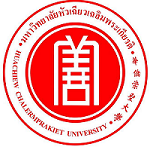Please use this identifier to cite or link to this item:
https://has.hcu.ac.th/jspui/handle/123456789/1440Full metadata record
| DC Field | Value | Language |
|---|---|---|
| dc.contributor.advisor | 覃东升 | - |
| dc.contributor.advisor | Qin, Dongsheng | - |
| dc.contributor.author | 张满峰 | - |
| dc.contributor.author | Zhang, Manfeng | - |
| dc.date.accessioned | 2023-10-30T04:01:09Z | - |
| dc.date.available | 2023-10-30T04:01:09Z | - |
| dc.date.issued | 2023 | - |
| dc.identifier.uri | https://has.hcu.ac.th/jspui/handle/123456789/1440 | - |
| dc.description | Thesis (M.A.) (Teaching Chinese) -- Huachiew Chalermprakiet University, 2023. | th |
| dc.description.abstract | Taking the "Developing Chinese" comprehensive series textbooks as an example and focusing on the study of China's international image, this paper adopts comparative analysis, literature research, and other relevant methods to analyze the process of self-construction of China's image in the textbooks and factors affecting the perception of national image, ultimately exploring what kind of national image should be constructed in international Chinese education. The analysis process of this paper is mainly divided into four parts. The first part introduces the connotation of national image and analyzes the characteristics of China's image presented in the "Developing Chinese" series textbooks. Based on this, the relationship between the textbook, cultural factors, and national image communication is analyzed. The second part is a horizontal comparison of the characteristics of national image construction in other international Chinese education textbooks. The third part mainly focuses on the study of the perception of China's image in the textbook. The factors influencing China's "national image" in the textbook are sorted out, the participation and influence of the textbook in the process of China's image communication and cognition are explored, and the factors affecting cognition are discussed. The limitations of the textbook in national image perception are discovered. The fourth part analyzes the above issues and proposes its own thinking results and suggestions. The study found that the factors of China's image presented in the "Developing Chinese" series textbooks are different at different stages. From the elementary to the advanced level, the categories, dimensions, and quantities of the presentation gradually increase, and the depth and breadth also gradually strengthen. The national image dimension in the textbook is implicit and more reflected in the subtle influence on the receiver, so attention should be paid to the impact of communication channels on the effect. As the main media of communication, textbooks play a very important role in cultural communication and national image communication. However, there are also many problems that restrict the important role of textbooks in communication. Therefore, the author proposes his own thinking: 1. The purpose of international Chinese education is to cultivate learners' ability to master the deep meaning of Chinese, understand Chinese values and thinking, and truly understand the profoundness of Chinese culture and the unique charm of Chinese art. 2. Whether in the formulation of textbooks or in the communication of national image through textbooks, we must adhere to China's dominant position and actively play our advantages. 3. In the actual use of textbooks, we should pay attention to the cognitive misconceptions of the "other". Therefore, the author proposes two concepts and methods that can be used in national image shaping: "foreign Confucianism and internal law" and "cultural transformation". It is hoped that in the future, theories such as sociology and psychology can be introduced to further explore national image issues in international Chinese education. | th |
| dc.description.abstract | 本文以《发展汉语》综合系列教材为例,以对中国国际形象的研究为切入点,采用比较分析,文献研究等相关方法展开分析。以期对教材中中国形象自我构建的过程和影响国家形象认知的因素有所研究,最终通过研究探讨国际中文教育的目的,应该构建什么样的中国国家形象。本文的分析过程主要分为五个部分。第一部分是先给出国家形象的内涵,开始分析《发展汉语》综合系列教材国家形象的展示特征。并据此分析教材和文化因素和国家形象传播之间的关系。第二部分是横向对比其他的国际中文教育教材关于“国家形象”塑造的特点。第三部分主要是对教材中中国形象认知的研究。梳理了教材中关于影响中国“国家形象”的因素,探究了教材在中国形象传播过程中的参与影响认知的传播途径,探讨了影响认知的因素。由此发现了教材在国家形象认知中的局限性。第四、五两部分是对上述问题进行分析,并提出自己的思考结果,提出建议。研究发现,《发展汉语》系列教材在不同阶段展现的中国形象因素是有所不同的。从初级到高级展示类别、展示维度和数量上逐渐递增,深度和广度上也逐渐加强。教材中的国家形象维度是隐性的,更多体现在对接受者潜移默化的影响,应该注意传播途径对效果的影响。而教材作为主要传播媒介,在文化传播和国家形象传播中的处于非常重要的地位。但是也有很多问题制约教材在传播中发挥重要作用。所以笔者提出了自己的思考:1.国际中文教育的宗旨在于培养学习者能够掌握汉语的深层含义,理解中国人的价值观和思维方式,真正领悟中国文化的博大精深和中国艺术的独特魅力。2.无论是在教材的制定中,还是在教材对国家形象的传播中,都要坚持中国主导地位不动摇,主动发挥主体优势。3.在教材的实际使用中要注意“他者”的认知误区。由此笔者提出了建议,在国家形象塑造中可以采用的“外儒内法”和“转文化”两种理念与方法。希望在未来可以引入社会学和心理学等理论,进一步的探究国际中文教育中的国家形象问题。 | th |
| dc.language.iso | zh | th |
| dc.publisher | Huachiew Chalermprakiet University | th |
| dc.subject | ภาษาจีน -- แบบเรียน | th |
| dc.subject | Chinese language -- textbook | th |
| dc.subject | การสื่อสารระหว่างวัฒนธรรม | th |
| dc.subject | Intercultural communication | th |
| dc.subject | การวิเคราะห์เนื้อหา | th |
| dc.subject | Content analysis (Communication) | th |
| dc.subject | 汉语 -- 教科书 | th |
| dc.subject | 跨文化交际 | th |
| dc.subject | 内容分析 | th |
| dc.title | 跨文化交流视角下国际中文教育教材中中国形象分析——以《发展汉语》为例 | th |
| dc.title.alternative | การวิเคราะห์ภาพลักษณ์ของจีนที่สะท้อนในหนังสือเรียนภาษาจีนนานาชาติจากมุมมองการสื่อสารข้ามวัฒนธรรม : กรณีศึกษาหนังสือเรียน "Developing Chinese" | th |
| dc.title.alternative | An Analysis of Image of China in the International Chinese Textbooks From the Perspective of Cross-Cultural Communication : A Case Study of the "Developing Chinese" Textbooks. | th |
| dc.type | Thesis | th |
| dc.degree.name | ศิลปศาสตรมหาบัณฑิต | th |
| dc.degree.level | ปริญญาโท | th |
| dc.degree.discipline | การสอนภาษาจีน | th |
| Appears in Collections: | College Of Chinese Studies - Theses | |
Files in This Item:
| File | Description | Size | Format | |
|---|---|---|---|---|
| ZHANG MANFENG.pdf Restricted Access | 1.34 MB | Adobe PDF | View/Open Request a copy |
Items in DSpace are protected by copyright, with all rights reserved, unless otherwise indicated.
